My Native Alternative to the Crape Myrtle
- Jennifer Anderson

- Jul 20, 2021
- 2 min read

Looking for late-summer blooms? You could plant an exotic crape myrtle. Or-- you could go for a little-known native that also offers beautiful blooms at a time when most other flowering trees have gone to berries.
The story behind the Franklin tree, Franklinia alatamaha, has been well documented: Naturalist John Bartram found the tree with its camellia-like blooms in the late 1700s on a river bank in Georgia and named it after his friend Benjamin Franklin.
Bartram and his son collected seeds from the tree--thank goodness--because within 50 years the Franklin had gone extinct in the wild. All Franklins today are believed to be descendants of the trees Bartram propagated at his home in Pennsylvania.
Why did the Franklin go extinct? No one knows for sure. But in his Native Trees, Shrubs & Vines (2002), William Cullina poetically describes the Franklin as “a lasting symbol of the plight of native species suffering under human onslaught.”
Cullina describes the tree as “splendid,” with flowers developing at the tips of the branches “as if consciously trying to hold back to let the anticipation build to a frenzy.”
The glorious, white, late-summer flowers are slightly fragrant and about 3 inches across and with a spot of orange in each center.
The Franklin grows anywhere between 10 and 20 feet and flourishes in full sun or part shade. Its branching is light and airy, and its glossy green leaves turn shades of red and orange in the fall.
If you’re OK with nativars, there is another option, for those unable to bear the wait of the Franklin. X Gordlinia grandiflora, or Mountain Gordlinia, is part-Franklin; it grows faster and blooms like crazy!
Photo: Copyright 2016 Tom Potterfield.
Sources:
Cullina, William. Native Trees, Shrubs & Vines: A guide to using, growing, and propagating North American woody plants. The New England Wildflower Society (2002).
Franklin Tree, Franklinia alatamaha, Arnold Arboretum of Harvard University. https://arboretum.harvard.edu/plant-bios/franklin-tree/.
Franklinia alatamaha, Missouri Botanical Garden Plant Finder. http://www.missouribotanicalgarden.org/PlantFinder/PlantFinderDetails.aspx?kempercode=q160.





Comments